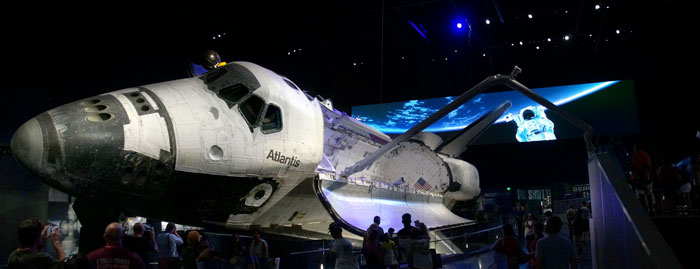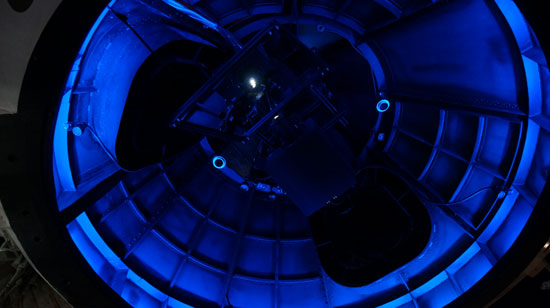Space Shuttle Atlantis exhibit now open at Kennedy Space Center Visitor Complex
The exhibit for the Atlantis shuttle orbiter opened this weekend. The presentation is very compelling. When you first see Atlantis up close you may be wiping a tear or two from your eyes!
 The front entrance of the Visitor Complex was recently updated and the skyline recently changed again. A copy of the shuttle’s external tank and solid rocket boosters now tower in the distance.
The front entrance of the Visitor Complex was recently updated and the skyline recently changed again. A copy of the shuttle’s external tank and solid rocket boosters now tower in the distance.
 The external tank and solid rockets draw you to the new Atlantis exhibit.
The external tank and solid rockets draw you to the new Atlantis exhibit.
 The new exhibit is behind the tank and solid rockets. It’s paired with an earlier attraction, the Shuttle Launch Experience.
The new exhibit is behind the tank and solid rockets. It’s paired with an earlier attraction, the Shuttle Launch Experience.
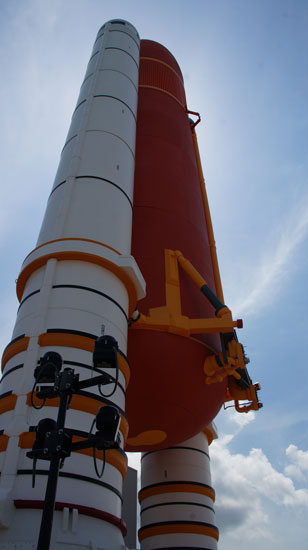 It’s very impressive to look up.
It’s very impressive to look up.
 One of the details to notice are these connections. This is where an orbiter mounted to the tank and also connected to the fuel lines into the tank.
One of the details to notice are these connections. This is where an orbiter mounted to the tank and also connected to the fuel lines into the tank.
 This is shuttle orbiter Discovery, as seen in the Smithsonian’s Udvar-Hazy Center near Washington DC. At top of the frame are the orbiter’s connections to the external tank. Match the connections here to the tank connections see in the previous photo. The connections have different configurations.
This is shuttle orbiter Discovery, as seen in the Smithsonian’s Udvar-Hazy Center near Washington DC. At top of the frame are the orbiter’s connections to the external tank. Match the connections here to the tank connections see in the previous photo. The connections have different configurations.
 One connection, as seen on Discovery.
One connection, as seen on Discovery.
 The second connection, but seen here on Endeavour at the California ScienCenter in Los Angeles.
The second connection, but seen here on Endeavour at the California ScienCenter in Los Angeles.
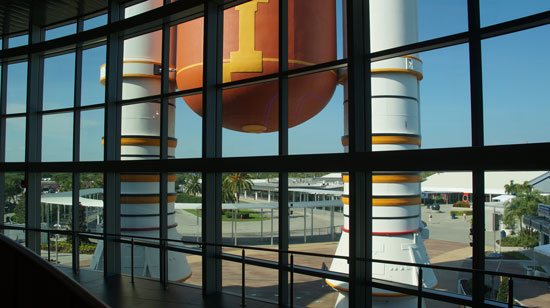 After entering the exhibit, you walk a ramp up to theaters. Along the way you have this view of the tank and solid rockets.
After entering the exhibit, you walk a ramp up to theaters. Along the way you have this view of the tank and solid rockets.
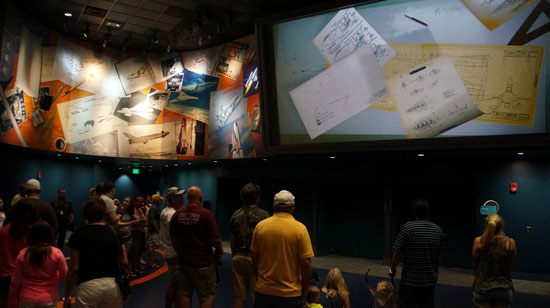 The first theater explains how the shuttle was developed from an idea of a spaceship with reusable components that would land like an airplane.
The first theater explains how the shuttle was developed from an idea of a spaceship with reusable components that would land like an airplane.
The second theater, which we’ve been asked to not take photos or video of, so as to not spoil the surprise, shows the shuttle in use. This theater also surrounds you with screens on four sides. Then comes a remarkable transition to Atlantis. You can’t believe your eyes. Is it really there?
 Atlantis is poised as if in orbit around the Earth. Not too many astronauts had this impressive view of the orbiter. They sometimes had this view from the Astronaut Maneuvering Unit (the “jet pack”), or while attached to the robotic arm when servicing the Hubble telescope. Now everyone can see this perspective of Atlantis!
Atlantis is poised as if in orbit around the Earth. Not too many astronauts had this impressive view of the orbiter. They sometimes had this view from the Astronaut Maneuvering Unit (the “jet pack”), or while attached to the robotic arm when servicing the Hubble telescope. Now everyone can see this perspective of Atlantis!
 Another one of the unique elements of this display is the ability to peer inside the windows, and see cockpit controls. (Exhibit reflections are in the right window.)
Another one of the unique elements of this display is the ability to peer inside the windows, and see cockpit controls. (Exhibit reflections are in the right window.)
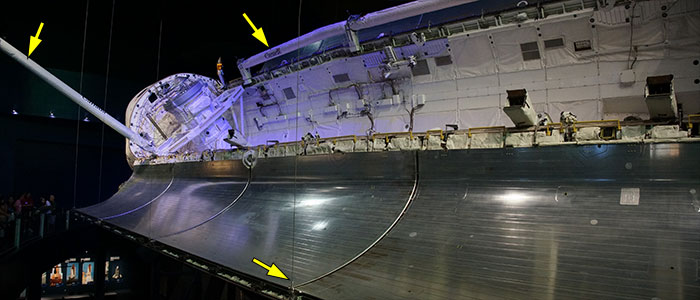 The payload bay doors are open. The doors are suspended by wires from the ceiling. The doors protected the payload during liftoff and landing. In orbit, the doors were used to transfer heat and cool the orbiter. The doors are lined with tubes carrying coolant. Did you know there are two robotic arms on the orbiter?
The payload bay doors are open. The doors are suspended by wires from the ceiling. The doors protected the payload during liftoff and landing. In orbit, the doors were used to transfer heat and cool the orbiter. The doors are lined with tubes carrying coolant. Did you know there are two robotic arms on the orbiter?
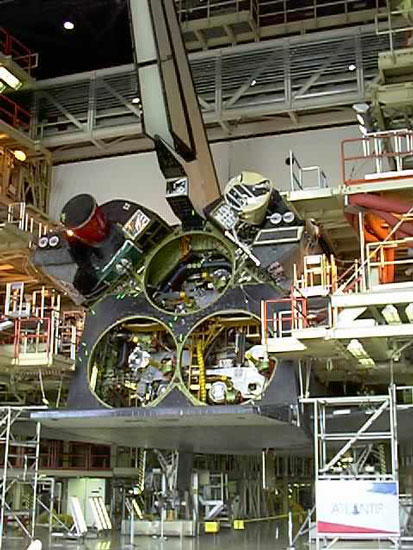 This is Atlantis in November 1999, when it was being serviced in an Orbiter Processing Facility at the space center. This view was seen during an employee open house.
This is Atlantis in November 1999, when it was being serviced in an Orbiter Processing Facility at the space center. This view was seen during an employee open house.
 A wing edge view unique to this display.
A wing edge view unique to this display.
 There are other displays in the gallery, many of them are interactive. Here, you can enter a demonstration of an orbiter cockpit.
There are other displays in the gallery, many of them are interactive. Here, you can enter a demonstration of an orbiter cockpit.
 Airplane pilots will recognize many of the displays.
Airplane pilots will recognize many of the displays.
 Behind the cockpit is where a robotic arm could be controlled.
Behind the cockpit is where a robotic arm could be controlled.
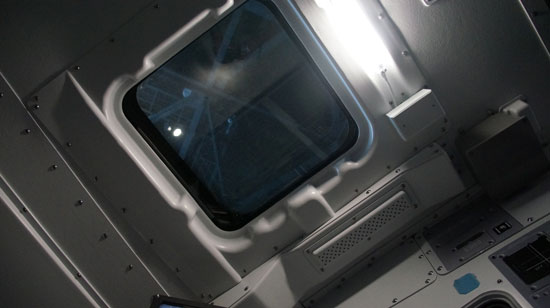 Be sure to look up. In orbit, astronauts could look through here to verify the robotic arm was moving as intended. This window was also where astronauts could look at Earth when relaxation or break time was scheduled.
Be sure to look up. In orbit, astronauts could look through here to verify the robotic arm was moving as intended. This window was also where astronauts could look at Earth when relaxation or break time was scheduled.
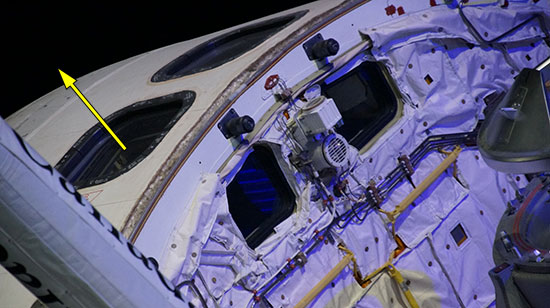 The same kind of window as seen on Atlantis.
The same kind of window as seen on Atlantis.
 Atlantis also has a dock to the International Space Station (and earlier, to space station Mir). Astronauts would crawl through the tube to reach the ISS, or return to the orbiter.
Atlantis also has a dock to the International Space Station (and earlier, to space station Mir). Astronauts would crawl through the tube to reach the ISS, or return to the orbiter.
 Nearby are similar-dimension tubes for guests to climb through. There are no age restrictions – if you’ve dreamed about being on the space station, here’s your chance to get an idea of what it is like to move between the modules. Of course, it’s much easier when you’re weightless.
Nearby are similar-dimension tubes for guests to climb through. There are no age restrictions – if you’ve dreamed about being on the space station, here’s your chance to get an idea of what it is like to move between the modules. Of course, it’s much easier when you’re weightless.
 One section of the demonstration tubes is themed like a Space Station service connection. This NASA video will help compare the above to the actual Space Station. This video is a tour of part of the ISS, going through some of the module connections.
One section of the demonstration tubes is themed like a Space Station service connection. This NASA video will help compare the above to the actual Space Station. This video is a tour of part of the ISS, going through some of the module connections.
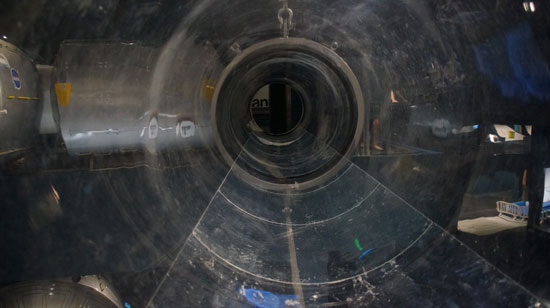 Another section of this interactive exhibit is crystal clear. It is a bit alarming at first to crawl out like this, but just think “water slide”. This tube is just like the clear water slide tubes at water parks, like at SeaWorld’s Aquatica.
Another section of this interactive exhibit is crystal clear. It is a bit alarming at first to crawl out like this, but just think “water slide”. This tube is just like the clear water slide tubes at water parks, like at SeaWorld’s Aquatica.
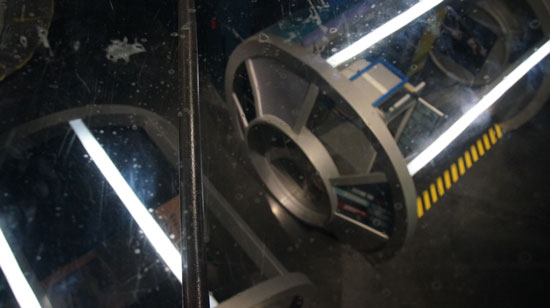 Looking down from the clear tube.
Looking down from the clear tube.
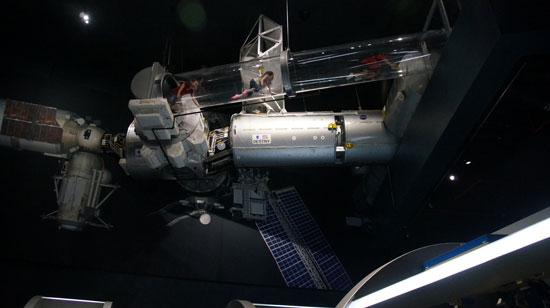 Some of the best fun you’ll ever have. Try it!
Some of the best fun you’ll ever have. Try it!
 This is a slide that mimics the steep descent curve the shuttle took to land.
This is a slide that mimics the steep descent curve the shuttle took to land.
 Guests have the opportunity to spin the actual tires that a shuttle landed upon.
Guests have the opportunity to spin the actual tires that a shuttle landed upon.
 It will be interesting to see if this scuffing remains over the years, or if it is polished smooth by the hands of many guests.
It will be interesting to see if this scuffing remains over the years, or if it is polished smooth by the hands of many guests.
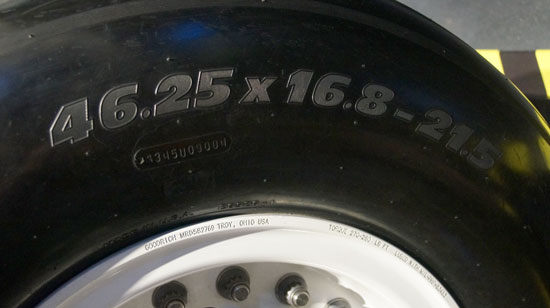 It could be a family exercise to compare the orbiter’s tire size with the tire size of the family car.
It could be a family exercise to compare the orbiter’s tire size with the tire size of the family car.
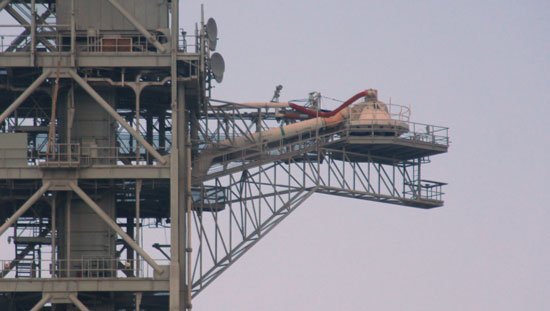 This is a fuel supply “beanie”. It’s mounted on top of the external tank before the final countdown completed and the shuttle lifted off. This is the beanie that is still at pad 39A.
This is a fuel supply “beanie”. It’s mounted on top of the external tank before the final countdown completed and the shuttle lifted off. This is the beanie that is still at pad 39A.
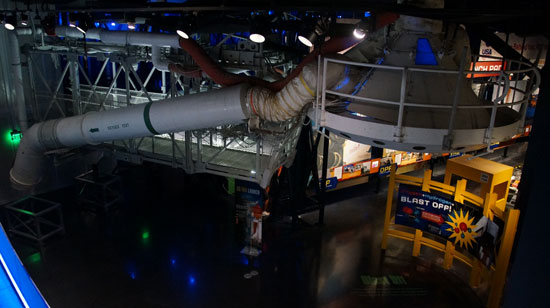 This is the actual beanie that was at pad 39B. The pad has been dismantled and reconfigured for use by the commercial flight program. The beanie was moved here.
This is the actual beanie that was at pad 39B. The pad has been dismantled and reconfigured for use by the commercial flight program. The beanie was moved here.
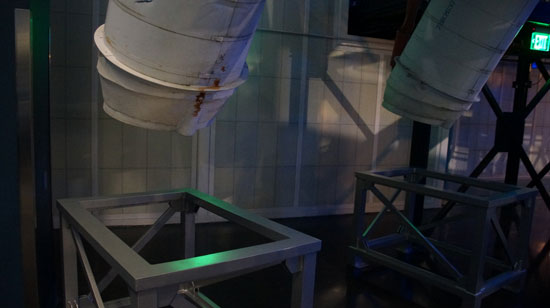 You can trace the fuel lines from the beanie back to this point, where dings, dents, scratches and corrosion are retained as they were after the last use.
You can trace the fuel lines from the beanie back to this point, where dings, dents, scratches and corrosion are retained as they were after the last use.
 Looking up into one of the lines. The mesh probably kept foreign matter out of the line during times of non-use.
Looking up into one of the lines. The mesh probably kept foreign matter out of the line during times of non-use.
 A space toilet display. (No, it is not an interactive display.)
A space toilet display. (No, it is not an interactive display.)
 Instructions for the space toilet.
Instructions for the space toilet.
 A full size copy of the Hubble telescope.
A full size copy of the Hubble telescope.
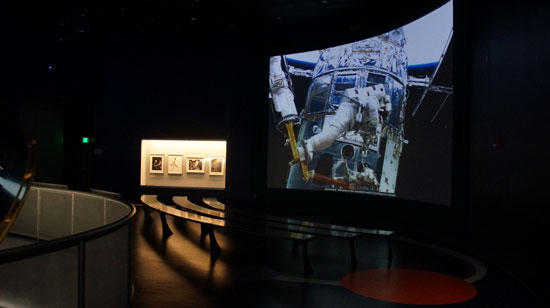 Nearby is a theater which shows a movie about the Hubble. Here we see an astronaut attached to a robotic arm.
Nearby is a theater which shows a movie about the Hubble. Here we see an astronaut attached to a robotic arm.
 We toured the Atlantis building last November, when it was under construction.
We toured the Atlantis building last November, when it was under construction.
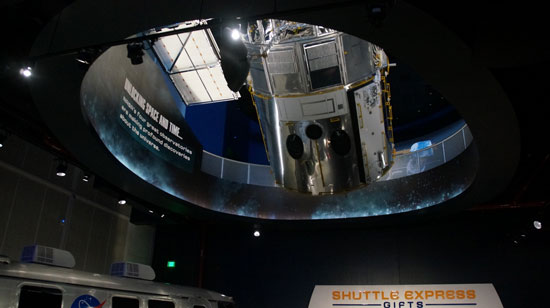 This same opening now has a upward view of Hubble.
This same opening now has a upward view of Hubble.
 Above, as the gallery is now, with Atlantis raised above. Below, Atlantis in the gallery just after it was towed inside. These camera angles are a bit different, the arrows help match four of the floor support beams. A curved line also represents where the curved wall was built after Atlantis was raised into position.
Above, as the gallery is now, with Atlantis raised above. Below, Atlantis in the gallery just after it was towed inside. These camera angles are a bit different, the arrows help match four of the floor support beams. A curved line also represents where the curved wall was built after Atlantis was raised into position.
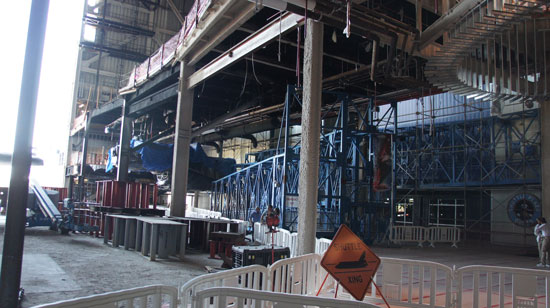 The blue gantry was in place in November 2012.
The blue gantry was in place in November 2012.
 Today, the gantry is used as the ramp up to the Shuttle Launch Experience.
Today, the gantry is used as the ramp up to the Shuttle Launch Experience.
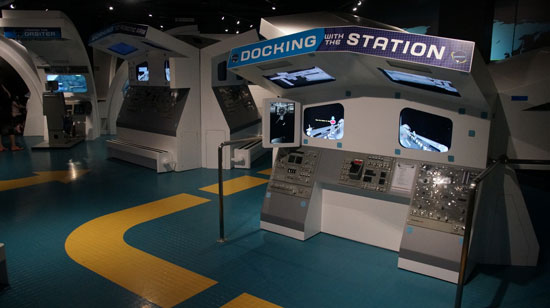 A large set of new interactive demonstrations to try at the exit of the Shuttle Launch Experience.
A large set of new interactive demonstrations to try at the exit of the Shuttle Launch Experience.
 All of the Commercial Space Program participants were present during this opening weekend. Here, we see Space-X, which has had two Dragon spacecraft visit the International Space Station so far. At right is one of the motors that Space-X developed for their commercial rocket. The shuttle program may be over, but commercial rockets are just beginning. An exciting, accessible future in space flight is ahead.
All of the Commercial Space Program participants were present during this opening weekend. Here, we see Space-X, which has had two Dragon spacecraft visit the International Space Station so far. At right is one of the motors that Space-X developed for their commercial rocket. The shuttle program may be over, but commercial rockets are just beginning. An exciting, accessible future in space flight is ahead.
 The new Atlantis exhibit is well worth seeing! Check our our posts to see Discovery at the Smithsonian National Air and Space Udvar-Hazy Center, and to see Endeavour in its temporary facility at the California ScienCenter.
The new Atlantis exhibit is well worth seeing! Check our our posts to see Discovery at the Smithsonian National Air and Space Udvar-Hazy Center, and to see Endeavour in its temporary facility at the California ScienCenter.
Here’s our video tour inside the new Atlantis exhibit:
Here’s the Opening Ceremony for the exhibit:
Photo Gallery:
Be sure to watch the July 4, 2013 episode of “Orlando Attractions Magazine – The Show” for our segment on the new Space Shuttle Atlantis exhibit.


